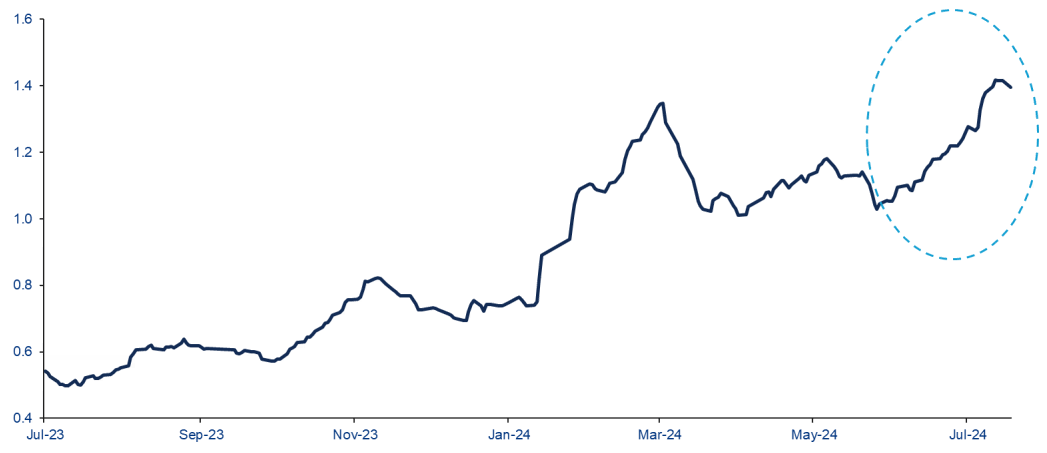The China Briefing
What's Behind the China A-Share Stability?

In the recent market turbulence China A shares have been notably stable, highlighting their diversification value
Please find below our latest thoughts on China:
- In the turbulent global equity markets of recent weeks, China A Shares have been notable for their stability, underscoring their diversification value to global portfolios.
- Since the end of Q2 there have only been five days when the MSCI China A Onshore index has moved by more than 1% in local currency terms.1
- In our view, one of the reasons for this is the ongoing support of the so-called “National Team” – a group of stateowned financial institutions – that have recently stepped up their activity.
- While there is no specific data published, an indication of this support comes from the pick-up in daily trading volume of onshore exchange-traded funds (ETFs).
Chart 1: China Onshore ETF trading volume (30 day moving average, CNY billion)

Source: Wind, Allianz Global Investors as at 31 July 2024. Past performance is not indicative of future results.
- This is consistent with an announcement earlier this year by Central Huijin, one of the main “National Team” members, that it had begun buying ETFs and would continue to increase the scale of its purchases.
- In contrast to the equity market, the Chinese currency has been unusually volatile in recent weeks, with the renminbi strengthening by around 2% since the final week of July.2 This is related to the surging Japanese yen and weaker US dollar.
- For the last two years, the renminbi and the yen have moved in a broadly similar pattern versus the dollar, the main reason being the meaningfully lower interest rates in China and Japan compared to the US. That, of course, is what funded the yen carry trade which so vigorously unwound in recent weeks.
- China’s capital controls mean the renminbi is not a traditional carry-trade funding currency. However, the rate gap to the US still matters because of the size of China’s export sector.
- Chinese exporters can choose when to convert their foreign earnings back into renminbi. Over the last decade, they have on average converted around 66% in the first half of each year.3
- The ratio in the first half of this year was a record low of 60.6% as China’s exporters looked to benefit from the higher returns on US dollar assets.4
- With markets moving to price in a peak in the US rate cycle, as well as potentially a weaker dollar, it is likely that China’s exporters will opt to convert more of their holdings into renminbi. This could put some modest upward pressure on the Chinese currency in coming months.
- For the People’s Bank of China (PBoC), this currency strength provides some much-needed relief. Previously, there had been concerns that rate cuts in China would further widen the rate differential with the US and therefore weaken the currency further.
- Looking ahead, the PBoC now has considerably more flexibility to reduce rates again in coming months. This flexibility will be much needed as China’s economy continues to stutter.
- China’s “Valentine’s Day” was on Saturday 10 August this year. Officially known as the Qixi Festival, it has been celebrated for over 2,000 years.
- Falling on the seventh day of the seventh month in the lunar calendar, according to legend (and akin to a Chinese version of Romeo & Juliet) it is the one day a year that mythical lovers Niulang, a cow herd, and Zhinu, a weaver, are able to meet on a celestial bridge.
- In a sign of the times, the hashtag “consumption plummets on Chinese Valentine’s Day. Are young people unwilling to pay the love tax?” became the number 1 trending topic on the Weibo platform on Saturday, drawing 200 million views.5
- While the challenging economy continues to weigh on discretionary spending, there is still strong evidence of trading down to cheaper price points. Box office revenue for the 2024 summer movie season, which runs from June to August, has exceeded 9 billion yuan (c.USD 1.25 billion).
- And as the Qixi Festival coincided with the Olympics, consumption of sports and outdoor-related items also surged. With China having won 37 of the 42 golds since table tennis was introduced to the Olympics in 1988,6 perhaps not surprisingly, sales of table tennis products grew by almost 50% compared to last year.7
Chart 2: Renminbi and Japanese Yen vs US Dollar (2 years, rebased to 100)

Source: Refiniiv, Allianz Global Investors as at 14 August 2024. Past performance is not indicative of future results
1 Source: Bloomberg as at 14 August 2024
2 Source: Bloomberg as at 14 August 2024
3 Source: Gavekal as at 7 August 2024
4 Source: Gavekal as at 7 August 2024
5 Source: MSN.Com as at 14 August 2024
6 Source: Reuters as at 10 August 2024
7 Source: JP Morgan as at 12 August 2024

